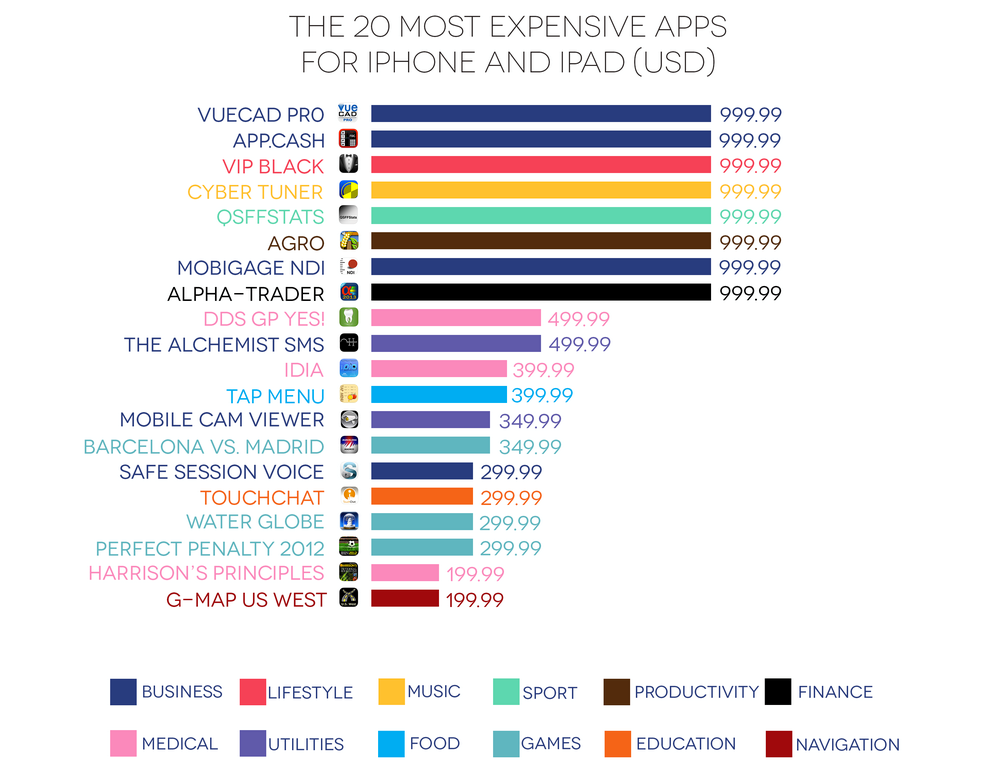Once we’ve updated our contacts, the first thing most of us do when getting our hands on a new smartphone is download the boatloads of free apps. From Google Maps and Facebook, to the document scanning Evernote Scannable, the most commonly used apps are free, making the prospect of even paying 10 bucks for app feel like rip-off. What if I were to tell you that that 10 bucks is just the tip of the iceberg, with the most expensive apps ranging between $200 and $1,199? Designer Jody Sieradsk i put together a nifty infograph showcasing the 20 most expensive apps.
The items on the list range from useless novelties such a $299.99 collection of interactive water globes to a virtual secretary for farmers, I mean “agronomists,” priced at $999.99.

Undoubtedly, most of us haven’t heard of the majority of the most costly items, and rightfully so, as most are very specific to a niche interest group.
Some of the more absurd items on the list include:
$199.99 — G-Map US Wes t: G-Map is a $199 dollar alternative to Google Maps with practically the same capabilities as Google Maps. It features voice-prompted turn-by-turn navigation, 3D view, and offline navigation.
$299.99 —Perfect Penalty : A terrible soccer video game not worth 300 bucks. Everyone knows FIFA is the definitive soccer video game franchise, none of whose entries cost more than $60.
$299.99 — Water Globe: I’m pretty sure that most real life water/snow globes cost far less than 300.
$299.99 — TouchChat AAC with WordPower: TouchChat is a full-featured communication app for people who have trouble using their natural voice as a result of autism, Down’s Syndrome, ALS, apraxia, and other conditions. Unlike the default text messenger, the app includes a pre-rendered selection of words or phrases. I suspect that if a sufferer of these conditions has enough reading comprehension to formulate a legible text message, than they can probably do that the same thing with a standard messenger infused with auto-correct and auto-suggest.
$999.99 — app.Cash: This pricey bad boy functions as a virtual cash register for that process transactions through to a printer to keep physical tabs on your spending. Other apps that perform similar functions exist and they’re free, so it’s uncertain why this app is so expensive.
$999.99 — QSFFStats: For 1000 bucks you’re now able to keep track of all plays of your favorite FLAG football team. Yay.
$1,199.99 — iVIP Black : An app known as “The Millionaire’s App,” iVIP Black is supposed to grant you VIP treatment from the company’s luxury partners for the price of $1,199. The website fails to mention who these “partners” are, but does suggest upon installation, owners must “certify they are High Net Worth Individuals with assets and/or income in excess of £1 million,” oo la-la indeed.
Now, on contrary, the items justifying their cost include:
$199.99 — Harrison’s Principles: Harrison’s Principles, more specifically called Harrison's Principles of Internal Medicine, Official Reference eBook for Doctors, Healthcare Professionals, and Students arguably justifies its $199 price tag if you believe that medical text books should be valued in the hundreds of dollars range.
$399.99 — iDIA, Diagnostic Imaging Atlas: Basically, the iDIA app is the veterinarian’s equivalent of Harrison’s Principles.
$499.99 — DDS GP Yes!: A dental app that organizes each patients data in an easy-to-read and comprehensible fashion, complete with diagrams.
$999.99 — MobiGage NDI: Aimed at the industrial market, MobiGage is an app designed for inspecting manufactured parts and assemblies. The app allows users to create, edit, track, and run measurement plans. The app is clearly industrial.
$999.99 — Agro: Agro is the agronomist’s definitive virtual secretary; an app that helps keep track of inspections, chemicals, crops, and pests on a farm, meaning the farmer(you), doesn’t have to “dilly-dally” with spreadsheets. That’s useful, I guess?
Source: BusinessInsider via Dadaviz
Advertisement
Learn more about Electronic Products Magazine





